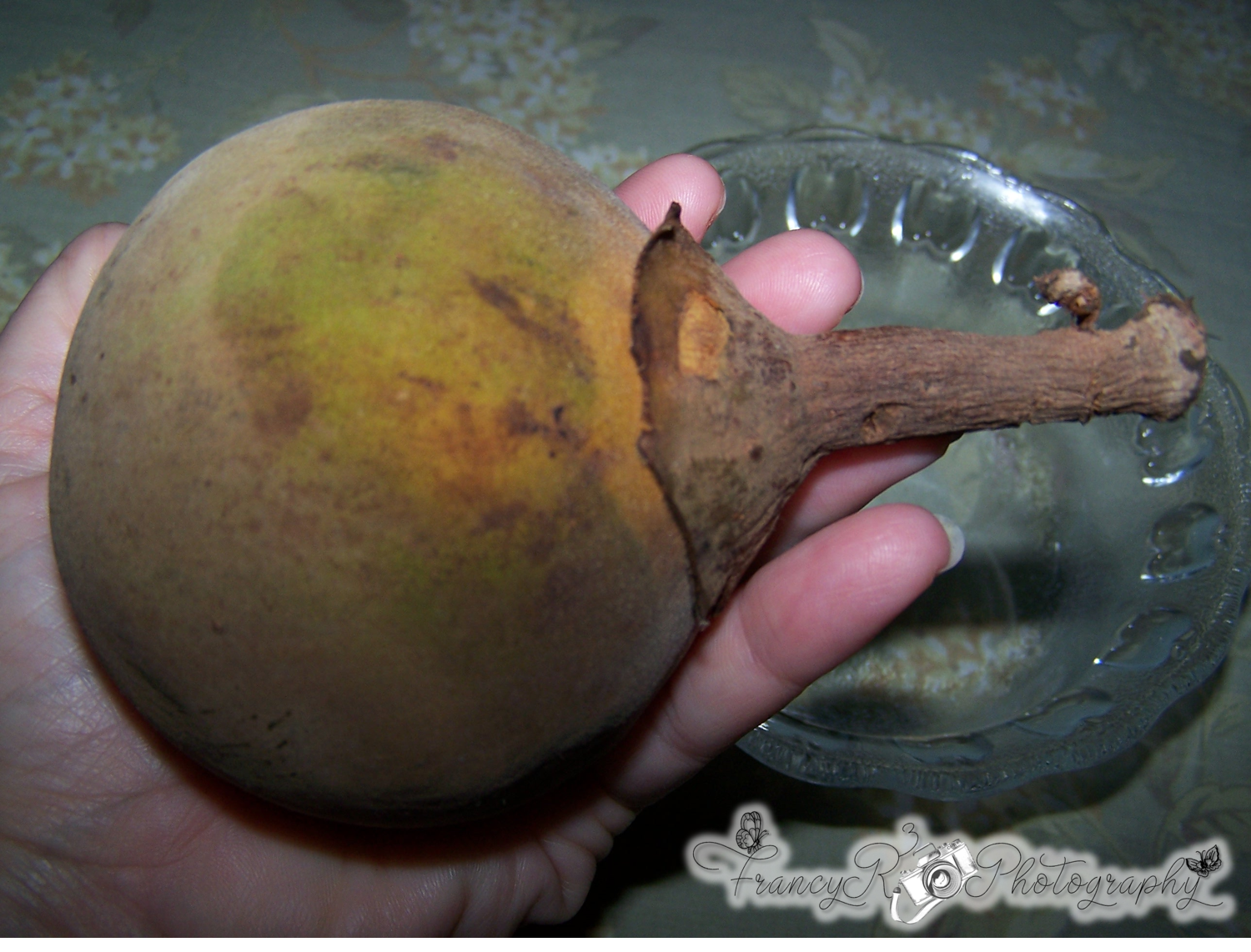Welcome Dear Photography Lovers
Bienvenidos Queridos Amantes de la Fotografía
Dear #AmazingNature community it is always a pleasure to be with you and share those wonderful things that the world around us offers us, today I will tell you about a curious fruit. Well, it is curious at least for me, I have tasted it only once and I recognize that, although it was not an unpleasant experience, it was strange.


Se preguntarán, ¿por qué extraña?, ok, trataré de explicarme, bueno lo primero es que esta fruta no tiene precisamente un aspecto atractivo a simple vista, de hecho, la compre con recelo. Por otro lado, cuando al fin le extraje su concha, de verla se me removieron recuerdos de la infancia, porque me recordó una fruta llamada mamey, que me encanta y tengo muchos años sin comerla. Finalmente, llego el momento de probarla y bueno, esto fue lo más extraño, tenía una textura como la de un mango, pero con más hilachas, sin embargo, su sabor, es un poco sin gracia. Me sentí como en la presencia de una quimera del reino vegetal, jajaja.
You may ask, why strange, ok, I will try to explain, well the first thing is that this fruit does not exactly have an attractive appearance at first sight, in fact, I bought it with suspicion. On the other hand, when I finally extracted its shell, the sight of it brought back memories of my childhood, because it reminded me of a fruit called mamey, which I love and have not eaten for many years. Finally, it was time to taste it and well, this was the strangest thing, it had a texture like a mango, but with more strands, however, its flavor is a little graceless. I felt like I was in the presence of a chimera from the vegetable kingdom, hahaha.



Esta extraña fruta, aquí en Venezuela se le llaman Zapote o Sapote, en otros sitios en cambio, se le conoce Chupa Chupa, Matisia Cordata o Zapote Sudamericano. Pertenece a la familia Malvaceae y al género Quararibea, por lo que en el ámbito científico se le denomina Quararibea Cordata. Es una especie, que disfruta los suelos fértiles y húmedos, siempre que no se inunden claro, por los que es, oriunda de bosques tropicales húmedos, así que, se le puede encontrar desde Perú hasta Brasil.
This strange fruit, here in Venezuela is called Zapote or Sapote, in other places it is known as Chupa Chupa, Matisia Cordata or South American Zapote. It belongs to the Malvaceae family and to the Quararibea genus, so in the scientific field it is called Quarararibea Cordata. It is a species that enjoys fertile and humid soils, as long as they are not flooded of course, so it is native to humid tropical forests, so it can be found from Peru to Brazil.



Según mis investigaciones en la web, el árbol de donde proviene esta extraña fruta se caracteriza por poseer un tronco erecto, liso, redondo y leñoso, muy apreciado en la carpintería. Cuenta con una gran altura, llegando a alcanzar en condiciones ideales entre los 40 y 45 metros. Posee una ramificación verticilada a través de la cual se distribuyen, sus verdes hojas en forma de corazón las cuales, son bastante grandes y le dan una apariencia muy ornamental a este árbol.
According to my research on the web, the tree from which this strange fruit comes from is characterized by an erect, smooth, round and woody trunk, very appreciated in carpentry. It has a great height, reaching in ideal conditions between 40 and 45 meters. It has a verticillate branching through which its green heart-shaped leaves are distributed, which are quite large and give a very ornamental appearance to this tree.



En el caso de las inflorescencias, poseen un color amarillento y emergen de una especie de cáliz de un color verde pálido. Un dato curioso sobre este árbol, es que, al florecer, se cubre completamente de flores, las cuales se distribuyen a través de todas sus ramas gruesas e incluso en el tronco.
In the case of the inflorescences, they have a yellowish color and emerge from a kind of pale green calyx. A curious fact about this tree is that, when it blooms, it is completely covered with flowers, which are distributed throughout all its thick branches and even on the trunk.



Ya les hablé sobre algunos detalles de este árbol y sus flores, ahora sí, hablemos de su peculiar fruto, que, por lo que tengo entendido en algunos lugares es muy popular. Lo primero que deben saber sobre este fruto, es que, aunque les parezca raro, se trata de una baya, la cual posee forma y tamaño similar a una bala de cañón. En otras palabras, parecen pequeños globos, que rondan mas o menos los 7 cm de diámetros, y los cuales poseen una cascara de color pardo verduzca, no muy apetitosa, por cierto, además, bastante dura y gruesa. En cambio, en su interior si tienen un color anaranjado muy llamativo, muy similar al de un mango maduro, al igual que la textura fibrosa de su pulpa. Lo que sí es distinto, y me recuerda más bien a un Mamey, es que la pulpa envuelve o encapsula de forma separadas varias semillas de forma de alargadas de más o menos 5 cm, de largo, son duras y no comestibles.
I already told you about some details of this tree and its flowers, now let's talk about its peculiar fruit, which, from what I understand in some places is very popular. The first thing you should know about this fruit is that, although it may seem strange, it is a berry, which has a shape and size similar to a cannonball. In other words, they look like small balloons, which are about 7 cm in diameter, and which have a greenish-brown skin, not very appetizing, by the way, and also quite hard and thick. On the other hand, inside they have a very striking orange color, very similar to that of a ripe mango, as well as the fibrous texture of its pulp. What is different, and reminds me more of a “Mamey”, is that the pulp envelops or encapsulates separately several seeds shaped elongated about 5 cm long, are hard and inedible.



El fruto del árbol de zapote se consume bien sea crudo o también se elaboran bebidas con él, según mi hermana, es delicioso si se le agrega leche, es decir, como merengada. Pero, lo mejor es que al parecer posee propiedades beneficiosas para nuestra salud, al aportar minerales como el magnesio, calcio y potasio. Esenciales para mantener en buen estado el funcionamiento de nuestro corazón, huesos y el proceso de coagulación, protegiendo con esto, además, las arterias. También, se supone que tiene propiedades antinflamatorias, antibióticas y antioxidantes.
The fruit of the sapote tree is consumed either raw or drinks are also made with it, according to my sister, it is delicious if milk is added, that is, as meringue. But the best thing is that it apparently has beneficial properties for our health, providing minerals such as magnesium, calcium and potassium. These are essential to maintain in good condition the functioning of our heart, bones and the coagulation process, protecting with this, in addition, the arteries. It is also supposed to have anti-inflammatory, antibiotic and antioxidant properties.

Como pudieron leer, el Zapote, aunque un poco extraña, es una fruta muy interesante y al parecer, también bastante beneficiosa para nuestro organismo. Así que, espero que les gustara los datos que compartí con ustedes, sobre todo, a @adalger y @bucipuci, ya que es mi participación en el concurso de esta semana, Amazing Nature Contest: FREE TOPIC - #2/5/22. Por ahora, no me queda más que despedirme, y enviarle muchas bendiciones.
As you could read, the Zapote, although a bit strange, is a very interesting fruit and apparently, also quite beneficial for our organism. So, I hope you liked the facts I shared with you, especially @adalger and @bucipuci, since it is my participation in this week's contest, Amazing Nature Contest: FREE TOPIC - #2/5/22. For now, I can only say goodbye, and send you many blessings.

Bibliographic References || Referencias Bibliográficas
https://es.wikipedia.org/wiki/Quararibea_cordata
https://estaeslahistoria.com/c-frutas/el-zapote/
https://www.naturalista.mx/taxa/327803-Matisia-cordata
https://www.rarepalmseeds.com/es/matisia-cordata-es

Contenido y fotografías de mi propiedad intelectual
Información Técnica
| Cámara | Pentax * istDL |
|---|---|
| Lente | * Pentax 18-55 |
| Iluminación | Luz Natural |
| Locación | Barcelona, Estado Anzoátegui, Venezuela |
Content and photographs of my intellectual property
Technical information
| Camera | Pentax * istDL |
|---|---|
| Lens | * Pentax 18-55 |
| Lighting | Natural Light |
| Location | Barcelona, Anzoátegui State, Venezuela |



The rewards earned on this comment will go directly to the people(@francyrios75) sharing the post on Twitter as long as they are registered with @poshtoken. Sign up at https://hiveposh.com.
Thank you for entering the competition.
I always like to read your competition articles. They contain very valuable information :-)
Thank you for your words, it is always a pleasure for me to participate.
You're welcome :-)
Dear @francyrios75, we need your help!
The Hivebuzz proposal already got important support from the community. However, it lost its funding a few days ago and only needs a few more HP to get funded again.
May we ask you to support it so our team can continue its work this year?
You can do it on Peakd, ecency, or using HiveSigner.
https://peakd.com/me/proposals/199
Your support would be really helpful and you could make a difference.
Thank you!
Hola @francyrios75, he oído hablar bastante del zapote, de verdad es interesante. Felicitaciones por tan buena información.